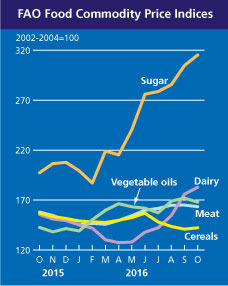The FAO Food Price Index averaged 172.6 points in October, up 0.7 percent for the month and 9.1 percent from a year earlier, with the staple grains' index rising for the first time in three months.
The Food Price Index, which has risen continuously throughout 2016 except for a brief dip in July, is a trade-weighted index tracking international market prices for five major food commodity groups.

 October's rise was driven primarily by jumps in sugar and dairy prices. The FAO Sugar Price Index rose 3.4 percent in October amid reports of production shortfalls in Brazil's Centre South region and India's Maharashtra state. The FAO Dairy Price Index rose 3.9 percent from September, led by rising prices of cheese and in particular butter, as a result of sustained internal demand in the European Union after a period during which stocks were drawn down.
October's rise was driven primarily by jumps in sugar and dairy prices. The FAO Sugar Price Index rose 3.4 percent in October amid reports of production shortfalls in Brazil's Centre South region and India's Maharashtra state. The FAO Dairy Price Index rose 3.9 percent from September, led by rising prices of cheese and in particular butter, as a result of sustained internal demand in the European Union after a period during which stocks were drawn down.
By contrast, the FAO Oils/Fats Price Index declined 2.4 percent from September, largely linked to weaker palm oil quotations as a consequence of sluggish global import demand. The FAO Meat Price Index also fell, dropping 1.0 percent in October, with the drop largely driven by slacker demand for European pigmeat from importers in China.
The FAO Cereal Price Index, meanwhile, rose 1.0 percent in October, buoyed by tightening supplies of high-quality wheat even as the overall prospects for global wheat harvests have improved.
FAO Meat Price Index
The FAO Meat Price Index averaged 163.4 points in October, down 1.7 points (1 percent) from its revised value for September. A decline in EU export prices for pigmeat, stemming from excess domestic supplies and a slackening in import demand from China, was the principal cause of the Index's decline. Additionally, Oceania bovine meat export prices continued to decrease, as increased domestic production in the United States obviated its need for external supplies. Conversely, Oceania ovine meat prices reached their highest level in almost two years, due to reduced output in both Australia and New Zealand.
Thursday November 10, 2016/ FAO.
http://www.fao.org



